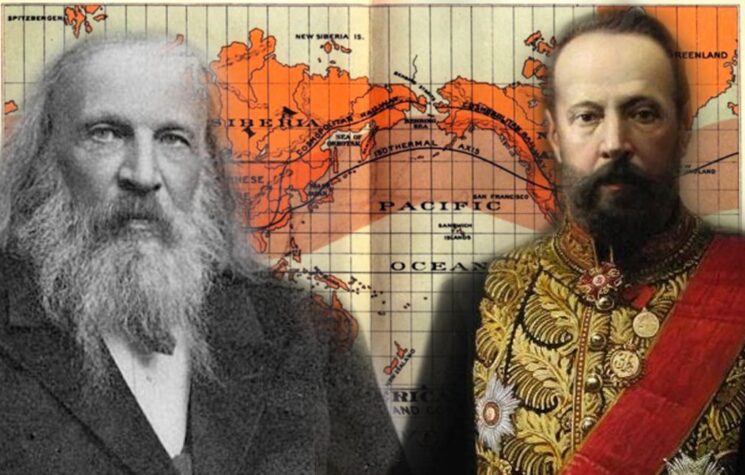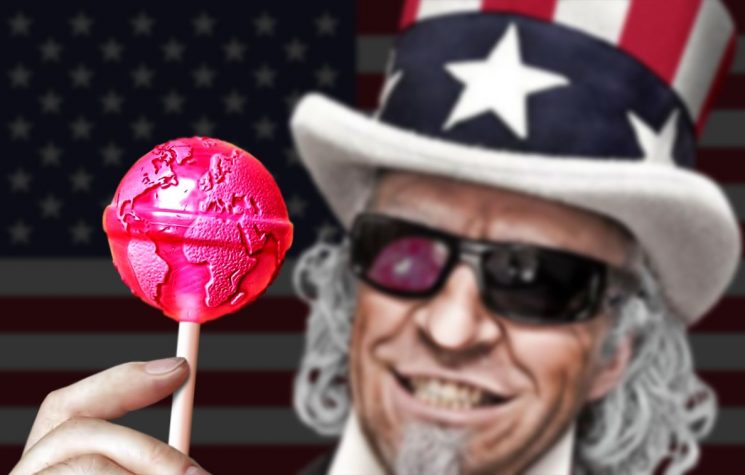Under the Keynesian takeover of Bretton Woods Trans-Atlantic nations became increasingly dominated by bloated bureaucratic systems while plans for genuine development were undermined, Matthew Ehret writes.
It is as if the battle lines of civil war have been drawn up between masses of Americans who have been led to believe in either a false “bottom up” approach to economics, as defined by the Austrian School represented by Friedrich von Hayek, or in the “top-down” approach of John Maynard Keynes. The former sacrifices the general welfare of the whole nation for the sake of the parts (i.e. individual liberties), while the latter sacrifices the individual liberties of each citizen for the sake of the general welfare (or at least some oligarch’s definition of what that should be).
In my last article, I introduced, in broad strokes, a history of the American System of political economy as advanced by Benjamin Franklin, Alexander Hamilton, John Jay, Henry Clay, Henry Carey, Lincoln, and McKinley. We reviewed how it was derailed by McKinley’s 1901 murder and was only revived 30 years later with Franklin Roosevelt’s 1932 presidential victory which put a stop to the 1933 Bankers Dictatorship.
Finally, we briefly explored how and why both John Maynard Keynes and Friedrich von Hayek whose ideas so deeply influence the polarization of the USA today, not only despised FDR but hated everything the republic stood for.
In this second installment of a three-part series, we will shed light on the anti-human ideas and the political operations that shaped the mind, the life and the politics of Lord John Maynard Keynes (1883-1946).

Keynes the Fabian Eugenicist
Although Keynes is heralded as the guiding light of the New Deal (and, as such defended by modern “Green New Dealers” and Great Reset technocrats wishing to impose a top-down system of governance onto the world), the fact is that Keynes not only detested Franklin Roosevelt, but also humanity more in general.
This will be seen clearly in 1) his devotion to the theories of Thomas Malthus, 2) his promotion of eugenics as a science of racial purification and population control, and 3) his general devotion to World Government as a leading member of the Fabian Society.
From his earliest days at Cambridge where he rose quickly to become one of the select Cambridge Apostles and shared, among other things, a lifelong friendship with Lord Bertrand Russell, Keynes devoted himself to the service of empire, becoming Knight of the Order of Bath and Order of Leopold by 1919.
His early 1911 book on Indian Currency and Finance (conducted during his five-year foray in the Empire’s Indian Office) ignored all actual political reasons for the famines plaguing India and argued coldly for a greater integration of the Indian banking system into the City of London controls which would somehow solve India’s problems. The provable reality was that Indian famines were coordinated tools of population control by the Malthusian elite of the British establishment who considered “war, famine and disease” as the gifts nature gave the strong to manage the weak.
While his later 1919 Consequences of the Peace appeared to be a reasonably sympathetic warning that the draconian Versailles reparations would do incredible damage and lead to a new world war, in reality, Keynes was displaying a cold sleight of hand. Serving as British Treasury representative to the Versailles Conference, Keynes never opposed fascism: he merely argued that a more liberal pathway to global fascism could be established under the direction of the Bank of England. His opposition, though, to the more violent approach preferred by conservative imperialists among the British Intelligentsia, was one of form more than substance.
Keynes and his fellow Fabians H.G. Wells, Bertrand Russell and G.B Shaw preferred the “slow and steady” “long game”, reminiscent of the Roman general Quintus Fabius Maximus who famously fought his enemies by slow attrition rather than in full-scale confrontation. Due to the public’s general ignorance of this strategy, we celebrate these Fabian Society luminaries for their pacifism, though in reality they were just as racist, fascist and eugenics-loving as their more short-sighted, hard-stomached counterparts sir Oswald Mosley, Lord Alfred Milner and even Winston Churchill.
Where the real solution to the hyperinflationary money printing and economic industrial shutdown of Germany during the post WWI years was to be found in the German-Russian Rapallo Agreement (destroyed with the assassination of American System Foreign Minister Walter Rathenau), Keynes and his ilk merely called for economic integration of the German banking and military system under Bank of England/League of Nations control.
Malthus, Eugenics and Keynes
Two theories advanced by the British Empire in response to the growth of the American System, first in the USA, and later internationally, were those of Thomas Malthus, and of Francis Galton, a cousin of Charles Darwin who coined the term “eugenics” in 1883. These sister concepts served as nothing less than religious precepts for the ruling elite as it desperately reorganized itself in the late 19th century.
It must be kept firmly in mind that at this period the British Empire was weak, and incapable of stopping the electric spread of win-win cooperation as the American System was sped around the world bringing progress and full-spectrum economics in its wake. One of the leading voices of the American System in 1890 was Colorado’s first Governor William Gilpin whose The Cosmopolitan Railway laid out a practical vision for a world united by rail, development, and national banking [see map].

Nevertheless, the Empire was determined to put an end to the spread of the American System.
A new breed of think tanks was created to shape the Empire’s grand strategy in the face of this growth of independent sovereign nations: these were T.H. Huxley’s X Club (c.1865), the Fabian Society (c.1884), and the Roundtable Group (c.1902). Where Huxley’s X Club coordinated with Cambridge, and the Roundtable Group/Rhodes Trust interfaced with Oxford, the Fabian Society created a new school called the London School of Economics. All three worked together as one unit.
Defining his misanthropic belief in overpopulation, Thomas Malthus (a British East India Company economist) stated in his famous 1799 Essay on Population:
“The power of population is so superior to the power in the earth to produce subsistence for man, that premature death must in some shape or other visit the human race.”

How could this crisis be avoided? Malthus answers it like only a devout imperialist could:
“We should facilitate, instead of foolishly and vainly endeavoring to impede, the operations of nature in producing this mortality; and if we dread the too frequent visitation of the horrid form of famine, we should sedulously encourage the other forms of destruction, which we compel nature to use. In our towns we should make the streets narrower, crowd more people into the houses, and court the return of the plague.”
Darwin himself admitted in his autobiography that his theory of evolution arose only after his 1838 reading of Malthus’ Essay on Population in which he “at last got a theory by which to work”.
So, Darwinism is really an extension of Malthus’s Hobbesian social theories onto all of living nature: a mere struggle for survival in a universe of entropy and diminishing returns. After a Malthusian version of biology was created, Darwin’s theories were in turn re-applied to human society as imperial tools for population control under the form of Galton’s Eugenics thus giving the same old evil practices of empire, war and slavery a “scientific validation”.
Although some apologists considered Keynes an anti-Malthusian- due to his theory that overpopulation might be overcome by encouraging spending rather than savings, which would, in turn, somehow create markets and thence new factories and more growth, the reality was the opposite. Keynes not only spoke gushingly of Malthus throughout his life as one of the greatest minds of all time, but even plagiarized many of Malthus’ own theories, for instance that of “demand deficiency causing unemployment and recession” outlined in his 1930 Treatise on Money. In his 1933 Essay on Malthus, Keynes wrote:
“Let us think of Malthus today as the first of the Cambridge economists—as, above all, a great pioneer of the application of a frame of formal thinking to the complex confusion of the world of daily events. Malthus approached the central problems of economic theory by the best of all routes.”
In his May 2, 1914 lecture Population, Keynes argued that government should “mould law and custom deliberately to bring about that density of population which there ought to be” and that “there would be more happiness in the world if the population of it were to be diminished.”
Saying that “India, Egypt and China are gravely overpopulated”, Keynes advocated using violence to defend the “superior white races” in this struggle of survival with the pacifist saying: “Almost any measures seem to me to be justified in order to protect our standard of life from injury at the hands of more prolific races. Some definite parceling out of the world may well become necessary; and I suppose that this may not improbably provoke racial wars. At any rate such wars will be about a substantial issue.”
As Acting chair of the Neo-Malthusian League, Keynes stated in 1927: “We of this society are neo-Malthusians… I believe that for the future the problem of population will emerge in the much greater problem of Hereditary and Eugenics. Quality must become the preoccupation.”
By 1946, Keynes, still a member of the British Eugenics Society (after serving as Vice President from 1936-1944) wrote in The Eugenics Review: “Galton’s eccentric, sceptical, observing, flashing, cavalry-leader type of mind led him eventually to become the founder of the most important, significant and, I would add, genuine branch of sociology which exists, namely eugenics.”
This was not ivory tower theorizing, but concepts with very real-world significance.
By 1937, Keynes’ General Theory of Employment was published in Nazi Germany. If anyone wishes to defend the idea that the economist was somehow an anti-fascist defender of “liberal values”, let them read his own words in the preface and then either redefine “liberal values” or their naïve idea of Keynes:
“I may perhaps expect to find less resistance among German readers than among English ones, when I put before them a theory of employment and production as a whole… The theory of production as a whole which is the object of this book, can be much better adapted to the conditions of a totalitarian state, than the theory of production and distribution of wealth under circumstances of free competition.”
Hitler himself was not only a devout eugenicist (whose racial purification policies emerged through the funding of the Rockefeller, Carnegie Foundations as well as British establishment), but was also a devout Malthusian saying:
“The day will certainly come when the whole of mankind will be forced to check the augmentation of the human species, because there will be no further possibility of adjusting the productivity of the soil to the perpetual increase in the population.”
Keynes was by this time extremely frustrated that the intention-driven system of political economy defining the New Deal under the helm of FDR’s leadership was not absorbing his trojan horse theories on employment, demand, and inflation. However, by the end of the war, many Council on Foreign Relation (CFR)-affiliated operatives pushing Keynesianism were making successful inroads into all branches of U.S. bureaucracy and penetrated the highest levels of the state department and treasury. At one point in 1943, Franklin Roosevelt commented on his understanding of this British Deep State operation when he told his son Elliot:
“You know, any number of times the men in the State Department have tried to conceal messages to me, delay them, hold them up somehow, just because some of those career diplomats over there aren’t in accord with what they know I think. They should be working for Winston. As a matter of fact, a lot of the time, they are [working for Churchill]. Stop to think of ’em: any number of ’em are convinced that the way for America to conduct its foreign policy is to find out what the British are doing and then copy that!” I was told… six years ago, to clean out that State Department. It’s like the British Foreign Office….”
The Battle for Bretton Woods
During the Bretton Woods conference (July 1-20, 1944), the two opposing paradigms, on the one hand the American System of anti-colonialism, and on the other hand the. British System of zero sum Malthusianism, went to war.
This war took the form of the battles waged by FDR’s trusted collaborator Henry Dexter White against John Maynard Keynes at Bretton Woods, where 730 delegates representing 44 nations gathered to settle the terms of the post-war order.
Although this conference is famously associated with the creation of the World Bank, International Monetary Fund, and General Agreement on Tariffs and Trade (GATT), it is falsely assumed to be a Keynesian creation. Keynes’ role as representative of the British Empire, much like his earlier role at Versailles in 1919, was defined by the intention at all costs to shape the conditions of a post-nation state world order on behalf of the City of London. Like Bertrand Russell and other Cambridge Apostles before and since, Keynes was trained in the sophistical deployment of statistics and mathematical logic to cover for the imperial rape of target nations.
Where Dexter White and Franklin Roosevelt demanded a U.S. dollar-backed post-war system of fixed exchange rates (to block speculation on commodities as a tool of economic war), theirs was not an idea premised on imperialism which FDR’s recorded battles with Churchill attest. Unlike the hard vs soft imperialism of Churchill and Keynes, FDR and his allies rather looked to a post-war system defined by U.S.-China-Russia friendship, and the internationalization of the New Deal applying a win-win approach to foreign policy.
At Bretton Woods, Dexter White and Henry Morganthau reached agreements to provide vast technology transfers to help South America industrialize. At the same time, large-scale programs modelled on the New Deal were presented by delegations from India, Eastern Europe, and China. It is noteworthy that the Chinese delegation introduced infrastructure plans first laid out by Sun Yat-sen in his 1920 International Development of China which both Mao, and Zhou Enlai endorsed alongside the Kuomintang’s Chiang Kai-Shek! Had these plans not been sabotaged, it is amazing to consider what sort of progress might have opened up for the Chinese 70 years before anyone heard of the “Belt and Road Initiative”.
At this early stage, Russia was still happy to be a founding member of the IMF and World Bank which were designed to act as cheap lending mechanisms for long-term, low-interest, high-tech global development.
Commenting on support for FDR’s post-war system of mutual interest, Stalin stated: “Can we count on the activities of this international organization being sufficiently effective? They will be effective if the Great Powers who have borne the brunt of the burden of the war against Hitler’s Germany continue to act in a spirit of unanimity and harmony. They will not be effective if this essential condition is violated”.
In opposition to this anti-imperial win-win system defended by Dexter White, and FDR, Keynes demanded a bankers’ dictatorship with a new supranational currency controlled by the Bank of England called the Bancor, as well as an international clearing house. The Bancor was later revived in a modified form when Special Drawing Rights (SDRs) were established, bringing the world closer to the sort of green synthetic hegemonic currency now promoted by the likes of Mark Carney, Klaus Schwab and George Soros under the veil of a Great Reset and Central Bankers Climate Compact.
Similarly to the League of Nations’ earlier design for World Government, Keynes’ arguments entailed the virtual castration of nation states, preventing their involvement in their own economic planning. These arguments also demanded that the USA fully recognize the legitimacy of the British Empire in the post war age (something which Dexter White and Morgenthau refused to do). In Keynes’ view, nation states should relinquish their sovereign financial controls to Malthusian technocrats managing the levers of production and consumption through a system of globally interconnected central banks.
Keynes’ model of governance would ensure that the sorts of INTENTION-driven large-scale projects that could finally end colonialism would not see the light of day.
The Keynesian World That Emerged Over FDR’s Dead Body
Under the Keynesian takeover of Bretton Woods that emerged during the Anglo-American special relationship created by Truman and Churchill, Trans Atlantic nations became increasingly dominated by bloated bureaucratic systems while plans for genuine development were undermined. With Roosevelt dead by 1945, Harry Hopkins dead by 1946, Dexter White dead by 1948, and Henry Wallace’s presidential efforts sabotaged by 1948, the last serious resistance to Britain’s reconquest of the USA had been put down.
After the war, eugenics-promoting organizations and think tanks changed their names while continuing their work, morphing into new forms by the 1960s such as the environmental movement, transhumanist movement, while not even the pharmaceutical/healthcare sector was left untouched.
In the next chapter we will close up this short series by reviewing the figure of Friedrich von Hayek and the Austrian School of Economics which emerged with the collapse of the Keynesian Bretton Woods in 1971 and the rise of the “Conservative Revolution”.





















































